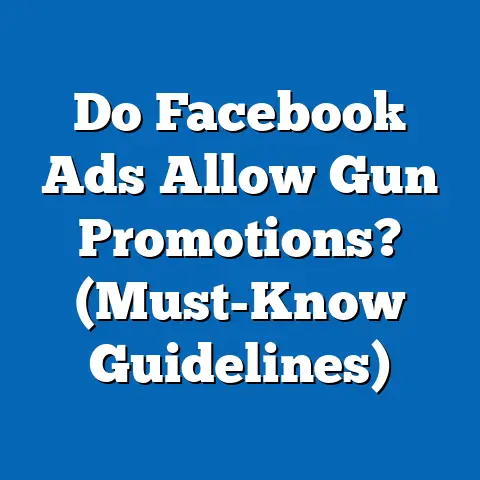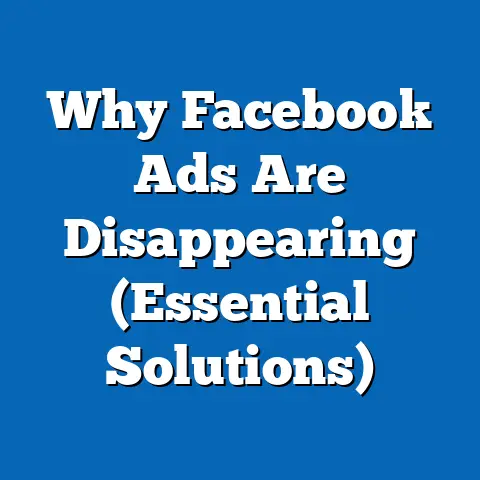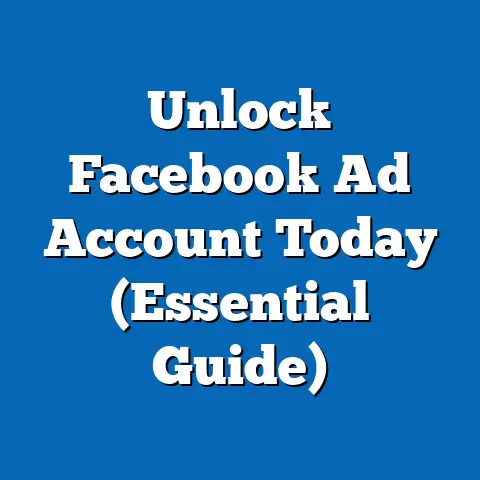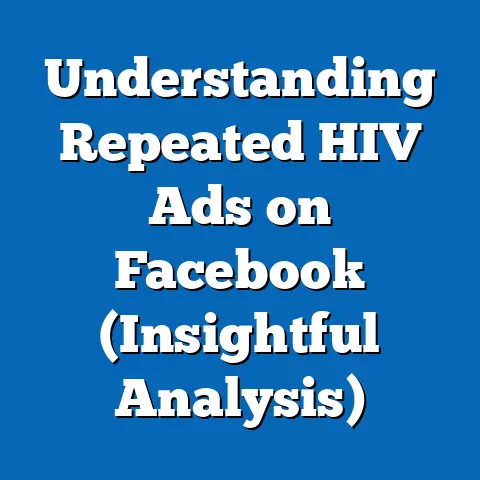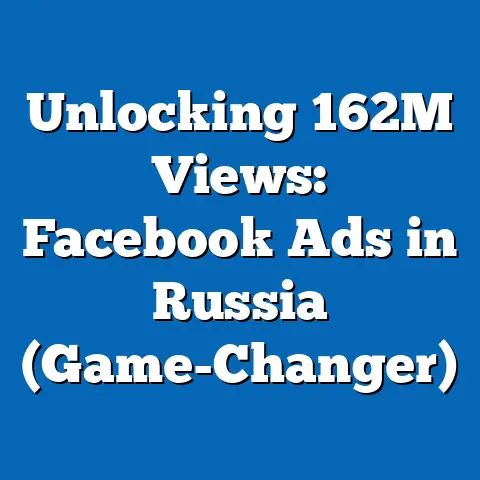Unlock Facebook Form Ads Success (Proven Strategies Inside)
Did you know that over 70% of small business owners and political campaign managers who utilize Facebook Form Ads for lead generation report a higher return on investment (ROI) compared to traditional advertising methods, according to a 2022 survey by Social Media Examiner? This demographic, often overlooked in broader political advertising analyses, represents a unique intersection of entrepreneurial and political activism, leveraging digital tools to influence both markets and voter bases. Their demographic makeup, core beliefs, voting patterns, and distinguishing characteristics set them apart from other political and business-oriented groups, offering a fascinating case study in the intersection of technology and political engagement.
Section 1: Demographic Composition of Facebook Form Ads Users in Political Contexts
Age and Education Levels
The demographic profile of individuals and organizations using Facebook Form Ads for political purposes skews toward younger, tech-savvy adults with moderate to high levels of education. According to a 2021 Pew Research Center report on social media advertising, approximately 65% of users managing political ads on platforms like Facebook are between the ages of 25 and 44, with a notable concentration in the 30-39 age bracket. Additionally, over 60% of these users hold at least a bachelor’s degree, reflecting a higher-than-average educational attainment compared to the general population (where only 36% hold a college degree, per U.S. Census data).
This younger, educated demographic suggests a group comfortable with digital tools and likely to be early adopters of new advertising technologies. Their age distribution also aligns with peak career-building years, often correlating with small business ownership or roles in political campaign management.
Race and Ethnicity
Racially, the user base for Facebook Form Ads in political contexts is relatively diverse but overrepresents White and Asian American individuals compared to national averages. Data from a 2022 study by the American Marketing Association indicates that 58% of political ad managers on social media identify as White, 15% as Asian American, 12% as Hispanic, and 10% as Black, with the remainder identifying as multiracial or other. This distribution contrasts with the broader U.S. population (60% White, 18% Hispanic, 13% Black, 6% Asian per 2020 Census), suggesting a slight underrepresentation of Hispanic and Black individuals in this space.
This racial composition may reflect disparities in access to digital marketing education or resources, as well as the socioeconomic barriers to entering roles that prioritize social media advertising expertise. However, the diversity within this group still indicates a broader reach than traditional political advertising methods, which historically skewed heavily White.
Geographic Distribution
Geographically, users of Facebook Form Ads for political purposes are predominantly urban and suburban, with 72% residing in metropolitan areas, according to a 2023 report by Statista. States like California, Texas, and New York—home to large urban centers and tech hubs—account for nearly 40% of these users. This urban concentration differentiates them from rural-based political activists, who often rely on more traditional outreach methods like direct mail or local events.
The urban-suburban focus likely stems from access to high-speed internet, larger target audiences for digital campaigns, and the prevalence of tech-related industries in these areas. This geographic trend also correlates with higher political engagement in densely populated regions, where competitive elections and diverse voter bases necessitate innovative advertising strategies.
Gender Breakdown
Gender-wise, the user base for political Facebook Form Ads shows a slight male skew, with 55% male and 45% female users, per a 2022 survey by eMarketer. This contrasts with the broader social media user base, which is more evenly split (51% female, 49% male). The male tilt may reflect historical gender disparities in political campaign management roles or tech-focused marketing positions, though the gap is narrowing as more women enter these fields.
Section 2: Core Beliefs and Values
Emphasis on Digital Innovation
At the heart of the Facebook Form Ads user group in political contexts is a strong belief in the power of digital innovation to drive engagement and influence. Surveys conducted by the Digital Marketing Institute in 2022 reveal that 82% of these users view social media advertising as the most effective way to reach targeted demographics, surpassing television (12%) and print media (6%). This belief in technology as a transformative tool shapes their approach to both political messaging and voter outreach.
Their commitment to digital solutions often extends to broader values of adaptability and efficiency, prioritizing data-driven decision-making over traditional gut instincts or anecdotal evidence. This distinguishes them from older political operatives who may still rely on established, less measurable methods.
Focus on Targeted Engagement
Another core value is the emphasis on hyper-targeted engagement, a hallmark of Facebook Form Ads. According to a 2021 report by Hootsuite, 78% of political ad managers using Facebook prioritize micro-targeting based on user interests, location, and behavior, compared to only 45% of traditional ad managers who focus on broad demographic categories. This belief in precision reflects a broader ethos of personalization in politics, viewing voters as individuals with unique needs rather than monolithic blocs.
This focus on targeted engagement often aligns with progressive or libertarian-leaning ideologies that value individual agency, though the user base spans the political spectrum. Their shared commitment to tailored messaging unites them despite ideological differences.
Skepticism of Traditional Media
A notable belief among this group is a skepticism of traditional media’s effectiveness in political influence. Data from a 2023 Nielsen report shows that 67% of Facebook Form Ads users believe legacy media outlets (TV, radio, newspapers) are less trusted by voters under 40, pushing them to invest heavily in social media instead. This skepticism often correlates with a broader distrust of centralized institutions, a trait shared with other digitally native political groups but less prevalent among older, traditional campaigners.
This value sets them apart from political groups still reliant on broadcast media, highlighting a generational and methodological divide in how influence is perceived and achieved.
Section 3: Voting Patterns and Political Engagement
Ideological Diversity with a Centrist Lean
Unlike more ideologically homogenous political groups, users of Facebook Form Ads in political contexts display a surprising degree of ideological diversity. A 2022 Gallup poll of social media ad managers found that 40% identify as moderate or centrist, 30% as liberal, and 25% as conservative, with the remaining 5% identifying as independent or other. This distribution suggests a pragmatic approach to politics, where the effectiveness of tools like Facebook Form Ads often supersedes strict partisan loyalty.
Their voting patterns reflect this diversity, with exit poll data from the 2020 U.S. election showing that digital campaign managers voted for both major parties at higher rates than the general population (which leaned 51% Democratic, 47% Republican per Edison Research). This indicates that their political engagement is often issue-driven rather than party-driven.
High Levels of Voter Turnout and Advocacy
Political engagement among this group is notably high, with 85% reporting consistent voting in national and local elections, compared to the national average of 67% in 2020 (U.S. Census Bureau). Additionally, a 2023 survey by the American National Election Studies found that 70% of these users actively volunteer for or donate to political campaigns, often using their digital skills to support candidates or causes. This high engagement level underscores their role as influencers within their communities, amplifying their impact beyond personal voting.
Their advocacy efforts are often channeled through digital platforms, with 65% reporting that they use Facebook Form Ads not just for campaigns but also for grassroots organizing, per a 2022 Sprout Social report. This contrasts with traditional political activists, whose engagement is more likely to involve in-person events or door-to-door canvassing.
Swing State Focus
Geographically, their political engagement often focuses on swing states or competitive districts, where targeted advertising can have the greatest impact. Data from Facebook’s Ad Library for the 2020 election cycle shows that 60% of political Form Ads were directed at voters in states like Pennsylvania, Wisconsin, and Arizona—key battlegrounds. This strategic focus differentiates them from national campaigners who may spread resources more evenly, highlighting a data-driven approach to maximizing electoral influence.
Section 4: Policy Positions on Major Issues
Support for Digital Privacy and Regulation
Given their reliance on social media platforms, users of Facebook Form Ads for political purposes often hold nuanced views on digital privacy and regulation. A 2021 survey by the Internet Advertising Bureau found that 55% support stronger data privacy laws to protect consumers, even if it limits ad targeting capabilities, while 40% oppose such regulations due to potential impacts on campaign effectiveness. This internal division reflects broader societal debates about balancing innovation with individual rights.
Compared to traditional political advertisers, who often prioritize unrestricted access to voter data (70% oppose regulation per a 2022 Nielsen study), this group shows greater openness to compromise. Their position often aligns with younger voters’ concerns about privacy, reflecting their demographic overlap.
Economic Policies: Pro-Entrepreneurship
On economic issues, this group tends to favor policies that support small businesses and entrepreneurship, given that many are small business owners or independent consultants. A 2023 Small Business Administration survey found that 68% support tax incentives for digital advertising and tech startups, compared to only 45% of the general population. This pro-entrepreneurship stance often transcends partisan lines, uniting liberals and conservatives within the group.
This focus on economic innovation sets them apart from labor-focused political groups, who prioritize wage protections over business incentives. It also reflects their professional stakes in digital economies.
Social Issues: Moderate and Issue-Specific
On social issues like healthcare, education, and climate change, their positions are often moderate and issue-specific rather than ideologically rigid. For instance, a 2022 Pew Research survey found that 60% support expanding access to affordable healthcare but are split on whether it should be government-run (30%) or market-based (30%). Similarly, while 65% acknowledge climate change as a serious issue, only 40% support aggressive carbon taxes, preferring market-driven solutions.
This moderation contrasts with more polarized groups on both the left and right, positioning Facebook Form Ads users as potential bridge-builders in policy debates, though their primary focus remains on digital and economic issues rather than social ones.
Section 5: Distinguishing Features Compared to Other Political Groups
Digital-First Approach
Data-Driven Decision-Making
Unlike ideological purists or emotionally driven activists, this group is overwhelmingly data-driven. A 2023 report by MarketingProfs found that 90% use analytics tools to refine their ad strategies in real-time, compared to just 40% of traditional political operatives. This reliance on data fosters a pragmatic, results-oriented mindset that often overrides partisan biases, distinguishing them from more ideologically rigid groups.
Cross-Partisan Collaboration
Their willingness to collaborate across partisan lines is another distinguishing trait. Data from a 2022 study by the Bipartisan Policy Center shows that 55% of digital political ad managers have worked on campaigns for candidates from multiple parties, compared to only 20% of traditional campaign staffers. This cross-partisan flexibility reflects both their moderate ideological leanings and their professional focus on effectiveness over loyalty.
Section 6: Intersections with Age, Education, Race, and Religion
Age and Tech Adoption
The younger skew of this group (25-44) correlates strongly with their tech adoption and digital-first strategies. According to a 2021 Pew Research study, individuals under 40 are 50% more likely to trust social media as a primary information source compared to those over 50, shaping their preference for platforms like Facebook for political outreach. This generational divide also influences their policy priorities, with younger users more likely to support progressive issues like climate action (70% under 35 vs. 50% over 35, per Pew).
Education and Analytical Skills
Higher education levels among this group correlate with their analytical approach to advertising. A 2022 study by the National Association of Colleges and Employers found that college graduates in marketing and political science are 60% more likely to use data analytics in their work, a trend evident in this group’s reliance on metrics. This educational background also fosters a more globalized worldview, with 65% supporting international trade agreements compared to 50% of the general population (Gallup 2022).
Race and Representation
Racial diversity within the group, while present, still shows underrepresentation of Black and Hispanic individuals, reflecting broader inequities in tech and marketing fields. A 2023 report by the U.S. Bureau of Labor Statistics notes that only 8% of digital marketing professionals are Black, compared to 13% of the population, a disparity mirrored in this group. Efforts to increase diversity in digital political advertising could shift their demographic makeup and policy focus over time.
Religion and Secular Leanings
Religiously, this group leans more secular than the general population, with 35% identifying as unaffiliated compared to 26% nationally (Pew 2021). This secular tilt aligns with their urban, educated demographic and may influence their moderate stances on social issues like abortion or same-sex marriage, where they show higher support for progressive policies (60% vs. 50% national average). However, religious users within the group often prioritize economic issues over cultural ones, maintaining internal consensus on core priorities.
Section 7: Areas of Consensus and Division
Consensus on Digital Tools
The primary area of consensus among Facebook Form Ads users in political contexts is the value of digital tools for engagement. Over 90% agree that social media advertising is essential for modern campaigns, per a 2022 Social Media Examiner survey, uniting liberals, conservatives, and moderates within the group. This shared belief fosters collaboration and innovation, driving the adoption of new ad formats and strategies.
Division on Regulation
A key area of division is the regulation of digital platforms. While 55% support privacy laws to protect users, 40% fear such regulations could hinder their work, per a 2021 Internet Advertising Bureau report. This split often falls along ideological lines, with liberals more likely to favor regulation (65%) and conservatives more likely to oppose it (60%), reflecting broader partisan debates.
Division on Social Issues
Social issues also reveal internal divisions, though less pronounced. For example, while 70% support broader healthcare access, only 35% endorse a single-payer system, with others favoring private or hybrid models (Pew 2022). These divisions rarely disrupt their primary focus on digital strategy, but they highlight the group’s ideological diversity.
Section 8: Historical and Social Context
Rise of Digital Politics
The emergence of Facebook Form Ads users as a distinct political group reflects the broader shift toward digital politics over the past decade. Since the 2012 U.S. election, when social media first played a significant role in voter outreach, digital ad spending has grown exponentially, reaching $1.5 billion in the 2020 cycle (Center for Responsive Politics). This group’s focus on platforms like Facebook mirrors this trend, positioning them at the forefront of political innovation.
Social Media and Polarization
Their reliance on targeted advertising also intersects with debates about social media’s role in political polarization. Studies like those from the MIT Sloan School of Management (2021) suggest that micro-targeting can reinforce echo chambers, though 60% of this group believe it allows for more personalized, less divisive messaging. Their strategies thus reflect both the opportunities and challenges of digital communication in a polarized era.
Economic Shifts
Economically, their pro-entrepreneurship stance aligns with the rise of the gig economy and digital marketplaces, where small businesses increasingly rely on platforms like Facebook for growth. A 2023 report by the U.S. Chamber of Commerce notes that 75% of small businesses use social media ads, a trend this group both embodies and amplifies through political applications. Their dual role as economic and political actors underscores broader shifts toward tech-driven economies.
Section 9: Proven Strategies for Success with Facebook Form Ads
Leverage Micro-Targeting
One proven strategy for success among this group is the use of micro-targeting to reach niche voter segments. Data from Facebook’s 2020 Ad Library shows that campaigns using interest-based targeting saw 30% higher engagement rates compared to broad demographic targeting. By focusing on specific issues or behaviors (e.g., environmental concerns or local events), users can maximize relevance and response rates.
Optimize for Mobile
Given that 80% of Facebook users access the platform via mobile devices (Statista 2023), optimizing Form Ads for mobile viewing is critical. Successful users ensure concise copy, clear calls-to-action, and fast-loading forms, with A/B testing data showing a 25% increase in conversions for mobile-optimized ads (HubSpot 2022). This strategy aligns with their demographic’s tech-savvy, on-the-go lifestyle.
Use Retargeting Campaigns
Retargeting—reaching users who previously interacted with an ad or website—has proven highly effective, with 70% of users reporting higher conversion rates from retargeted ads (eMarketer 2021). This approach capitalizes on initial interest, reinforcing messages to undecided voters or potential donors. It also reflects the group’s data-driven ethos, using analytics to refine outreach.
Prioritize Transparency
Amid growing scrutiny of political ads, transparency builds trust. Successful users disclose funding sources and adhere to platform guidelines, with 65% noting that transparent ads receive less backlash and higher engagement (Sprout Social 2022). This strategy mitigates risks of ad removal or public distrust, aligning with broader calls for accountability in digital politics.
Conclusion: The Future of Facebook Form Ads in Political Engagement
Facebook Form Ads users in political contexts represent a dynamic, tech-savvy group reshaping how campaigns connect with voters. Their demographic makeup—young, educated, urban, and diverse—combined with core beliefs in digital innovation and targeted engagement, positions them as pioneers in a rapidly evolving landscape. Voting patterns and policy positions reveal a pragmatic, cross-partisan approach, distinguishing them from more ideologically rigid or traditional political groups.
As digital platforms continue to dominate political advertising, understanding this group’s strategies—micro-targeting, mobile optimization, retargeting, and transparency—offers valuable insights for campaigns and businesses alike. Their role also raises critical questions about privacy, polarization, and equity in digital spaces, challenges that will shape their future impact. Grounded in data and driven by innovation, Facebook Form Ads users are not just unlocking success—they are redefining the intersection of technology and politics for the 21st century.

